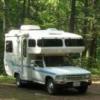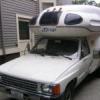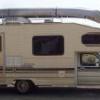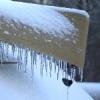Search the Community
Showing results for 'overhead rebuild'.
-
So far in my rebuild project I've rebuilt several things. One of the thing was the cabinet area around the range. While I was in there, I figured I would not do much baking in the rig and if I wanted to bake, I'd bring a small toaster oven. So I pulled the rather heavy range out. So then I was determined since our fridge was bad and I was going to replace it with a dorm fridge to pull ALL the propane out. I guess I just figured "why mess with having to refill it, leaks etc.". So I'm replacing the water heater with a Bosch 2.5 gallon (or 4 gallon) electric 110V. I'm pulling the furnace and will enjoy heat from space heaters or overhead heat. (When traveling in extreme cold we'll bring a portable propane tank & Big Buddy heater) For stove usage we are going to just keep a "hot plate" / 1 or 2 burner plug in "thing". Also, we can keep the fridge cold while driving because we have the dorm fridge that works on 110V hooked up to a small inverter. The fridge uses 140 watts only. So we'll have a nice cold "RV fridge" powered from the alternator going down the road that was only $120. The propane tank I guess I'll just drop out & save the RV some weight. Perhaps I'll install some kind of storage box behind the "door area" where the propane is now. I guess this job is pretty straight forward without any major concerns (yes the propane tank is 100% empty). Has anybody else done something like this? Pull all the propane & just decided to go off electricity? Experiences or tips?
-
i am the new owner of a 1985 toyota dolphin. the thrill of my purchase was partially diminished when the first real rain showed me that every overhead hatch was a leak source. my immediate conclusion is that these should be replaced with marine hatches that are designed to stand up to adverse conditions. my much larger concern is how to deal with the roof itself which feels awful underfoot, and cries out for a rebuild. has anybody dealt with this issue? i would love to hear opinions. also, if anybody knows where the owner or mechanics manuals can be purchased i would greatly appreciate knowing. thank you.
-
Weight Limits for Cabover Bunks
Dolphinite no longer here replied to Aeolus's topic in General Discussion
I have a 1985 Dolphin with the rear dinette/bunk deal. My wife and I sleep there most of the time and, yes, sometimes it would be nice to have the bed there instead of the dinette for those times when you just want to flop down for a quick nap. Both of us added together weigh about 400 pounds and the overhead bunk supports us just fine on the few times we've slept there. I did, though, rebuild the entire thing because it was rotted through and through. That kind of damage is common in these Toyota motorhomes and it is imperative that you pull the mattress off and really poke around there looking for wrinkled paneling on the bed surface where it meets the side and front walls. Check the walls where they meet the bed surface, too. Your experience as a boat builder should give you a big leg up on finding rot. On another note, what kind of boat work did you do? I'm a retired shipwright and I worked mostly in Alaska and the Puget Sound area for a little over thirty years doing mostly repair on wood boats except when the occasional juicy new build came up. John Jamieson -
Hard wood floor
Lance Andrus replied to Tressa's topic in Improvement and Do-It-Yourself Projects you have done to Share!
This past summer I ripped out the carpet in my Coachman and installed vinyl flooring. Had some mold under the carpet so I sprayed a bleach solution on the floor and swept it out good Then sprayed KILZ over the entire floor and let it cure for 2 days before I layed down a new 1/4" underlayment. Couple that with a total step rebuild and my floor is so much better than it was with carpet. It took me about 3 weeks working on and off. Going to rebuild the overhead compartment walls this winter. -
Some updated picts of rebuild.Installed as much paneling as i could until got to bath where frp is going. Still have to frame bath walls. SO decided it was time to demo overhead bed area. More rot! HA and i forgot two layers thick of paneling in front. More window frames to build and install. Oh well,...
-
Hello All, I will be taking the Toyota out of winter storage this month in order to do some work on her. I have a soft spot around the side window of the overhead cab bunk area, on the drivers side. The soft spot is in front of the window, and is about 8 inches by 6 inches square, but the wall feels solid below it and above it, so it appears to be a window frame leak (I am hoping). Also, the base/floor of the overhead cab area feels solid and no signs (no smell, stains, or warping) of water damage. I am hoping that I all need to do is remove the section of wall in front of the window, about a 2 foot x 2 foot triangle shaped section, and maybe replace/repair a wood beam/brace. Does this sound about right, or is there a lot more going on behind the wall? Would I need to peel back the outer fiberglass or is it possible to do all the repairs from the inside? I have seen a number of overhead cab rebuild pictures, but they seemed to involve a lot more damage, and damage to the base/floor of the bunk. I am pretty sure my damage is isolated to just in front of the window. I just wanted a few opinions to help me determine how much of a job I will be getting myself into. Also, as far as the wall material goes, can I use 1/8 inch plywood or is there a better material to use. I am assuming that I will end up glueing/staple/nail the wall material to any wood beams/braces that I find in the wall. Thanks for any advise you can give. Dennis...
-
Hello everybody I did ask A couple of employees at my local hardware stores as far as the fiberglass panels are concerned, I was told that it would probably take power stapler to shoot the staples through it and that the fiberglass weighs about the same as the 1/8 wood skins. I also just purchased a repair your RV book from amazon.com. I should have it this Sat. I will let everybody know if the book is any good. Also it is my understanding that with the dolphin the outside sheet metal slides off in sections you will have to remove all screws doors windows and compartment doors in areas you are working in. and the panels slide out in sections. That's all I have been able to find out at this time Winston Winston, You're right about having to take all the window frames, access door frames and any marker lights that are mounted on the sides of your motorhome. You also have to remove or the corner moldings at each end of the rig since they overlap the panels a bit. The side was paneled starting from the top and working down with the staples in the bottom of that panel. The next lower panel was then pushed up into a small groove on the upper panel, covering the staples, and so on... Sound confusing? As soon as you start removing trim and access door frames, it will become apparent how to proceed. You will have to start removing panels at the bottom and work your way up. The panels on my '85 Dolphin are stapled in place with narrow crown staples. You'll need some kind of small pry bar or thin blade screwdriver to get under the heads of the staples and pry them up from the surface. Once they're standing a little clear of the surface, use a pair of pliers to grab them and pull them out. It seems like there's thousands of them, but stay with it and eventually you'll get them all out. Once a panel is staple and screw free, be careful how you handle it. They are floppy and will kink or fold over easily! I used a long piece of 1x6 under each panel to support it while I carried it into my shop. A good way to fasten those overhead fiberglass panels is by using short stainless steel screws and finish washers. (Some people call them cup washers) They aren't hidden and are meant to be in plain sight, but give a finished, professional look. I suppose you could cover the rows of fastenings by using a strip of molding held up with, possibly, velcro, but in my opinion, the screws and washers don't look bad at all. One advantage of using the screws and finish washers is that you can easily drop a panel down by simply removing the screws. This gives you easy access to the interior of the ceiling in case you want to add some wiring, insulation-whatever. The screws have to be screwed into framing that's underneath, of course, and the panel pieces have to be cut so that they meet on the ceiling framing. Kinda' like sheetrocking your house walls, the edges need something to land on for fastening down. I have some photos of my Dolphin on the Toyota Motorhomes Yahoo site under '85 Dolphin Rebuild. Maybe some of the pics will help although Winter has slowed things down considerably since I'm working outside and uncovered. John
-
HELP! We've had extreme water damage on bed area and I have removed all rotten wood, foam, everything. All we have left is the fiberglass that wraps around the overhang above cab. Anyone out there that can help, or has tackled this same repair problem. What would be the best materials to rebuild, what kind of sheet foam, how do I go about laminating it together. What recommendations for everything? HELP !! Smitty 1990 Toyota 21' Micro-Winnie
-

looking for 1 ton rearend for a 84 coachman
turtle replied to roddoc61's topic in General Discussion
The first thing you should do is go over the coach and truck chassis to make sure that it is sound and worth the time and effort to expend the money on a replacement axle. Go through the coach body and poke at the ceiling around the vents (both the air and sewer vents) to see if there are any "soft spots". Poke around all the windows. remove the cushions from the overhead and look at the flooring. Open all of the overhead cabinets and poke at the walls near the roof inside of them. When I say poke around I mean stuff your fingers at the walls and ceilings. You should NOT feel any soft spots, if you do there is structural damage under the paneling and depending on how sever the damage the cost to repair can exceed the purchase price of your vehicle (unless you can strip the interior, rebuild the wall/ceiling interior walls, and replace the interior yourself). You are going to find some problems unless the coach was kept inside of a garage all of its 24 years of existence. If it is not severe/terminal you can move on to a mechanical evaluation. Suspension wears quickly on these motor homes because of the excessive weight they carry around. Have a mechanic look at the engine, trans/clutch (or auto), the front suspension, brakes, etc. If it passes all of these "tests/trials" THEN you can consider getting a rear axle and install it. Your vehicle has the narrow frame so you "should" try to find an axle from a 1985-1988 truck. Axles from 1989-1993 will have wider springs and require more fabrication. You can use a later model axle, it will just add a little more to the cost. -
The Toyota Groups site has a photo album in the pictures. The Toy owner rebuild the rear bath and front overhead . Title is 1990 Dolphin by dbabsjr. Good luck
-
Mr Bajadulce.. I envy the agression with which you tackled your project. Have you weighed your beast to determine "travelling weight" ? I have the impression my Dolphin is really heavy. I am looking forward to the orgy of destruction in fall, when I intend to cut the beast down to just the cab/chassis (if I haven't found a way to pull the cab/coach in 1 peice). If I could find a replacement Cab, I would be tempted to plonk that on to make a cab chassis to enable the vehicle to be useable while I completely rebuild the coachwork next year. I have a few really crazy ideas for the coachwork including a "forward control" version which will eliminate the overhead bed and toyota cab and basically stretch the coachwork forward like a bus. Driver and passenger will be elevated above the front wheels and step down into the main cabin. Put in swivel seats so that one can face rearwards. Build the whole thing unitary fashion (self supporting) and have 6 distributed coach/chassis mounting points. The front axle could be widened (oooo, I'm doing so much work on the front end as it is...) in fact it should be if the vehicle will be the same width all the way to the front. No more ducking under the front overhang to get in, no more whacking your head on it when getting out.... I'm still torn regarding what material to use for the rebuild. Listening to the wind noise from the "brick like" aerodynamics for 1200 miles, I really had some major fantasies about how quiet a nice smooth aerodynamic nose made in composite might be. Something like the front of the Sprinter based RV's.. Direction undecided, but the road will go somewhere... Keith
-
what should I look for when buying a dolphin motorhome
Carol replied to Grace's topic in General Discussion
Greg forwarded me your message - I have just gone thru a massive rebuild on my overhead and entire upper driver side to the tune of $8600, done by Dr. George here in Sacramento - and I know he didn't charge me what he could have, given the extent of the damage. Gregg is correct that the interior framing in particleboard, and when wet, disintegrates. My rig looked really nice, inside and out, until it started separating from the drivers door to the coach and up the overhead. I'm at work and don't have the pictures available. but it was much worse when we got into it. I decided to go ahead with the rebuild as mine is a 91 with 45K, and when the head gasket recall was done, I had them replace timing belt, all new spark plugs/wires, hoses, etc. so it's like new. Everything else works wonderfully, and I put the money into it thinking I'd keep it 'til I can't drive anymore! And I love the silly thing - had it to Union Valley Reservoir for 6 days over the weekend and everyone loves it. To make a long story short, unless this motorhome is VERY cheap (or free), has low miles and if everything works, I wouldn't consider it. There's a number of decent rigs around if you look. And Dr. George will gladly take a look at any rig under consideration - free for a 20 minute once-over, $100 or so to verify all systems work as they should. Sorry this is so long, but owing one of these toyhouses is a comittment and there's always something to do/fix and you must be prepared! Any questions, contact me directly at clundsten@sbcglobal.net. Thanks! Carol















